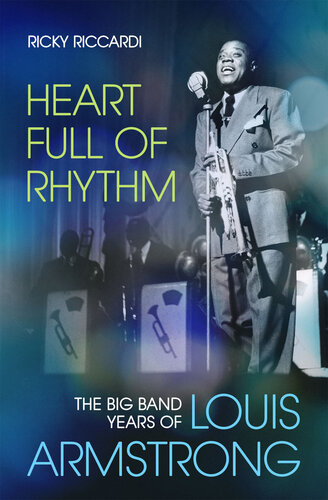
Heart Full of Rhythm
The Big Band Years of Louis Armstrong
کتاب های مرتبط
- اطلاعات
- نقد و بررسی
- دیدگاه کاربران
نقد و بررسی

September 1, 2020
Riccardi (director, research collections, Louis Armstrong House Museum; What a Wonderful World ) tackles the neglected middle period (1929-49) of jazz legend Louis Armstrong's career. Starting with Armstrong's rise to national prominence in New York City, Riccardi details how the artist faced troubles with warring gangs, a nagging sore lip, angry wives, a marijuana habit, rising boppers, and the musicians' union while gradually crossing over to a pop audience. Compellingly, the author illuminates the pivotal role of managers Tommy Rockwell, tough guy Johnny Collins, and Al Capone associate Joe Glaser on Armstrong's climb to pop stardom. He portrays his subject as a generous, ambitious, hardworking, comedic, and audience-focused musician and entertainer who retained a sunny optimism despite the unrelenting racial discrimination that plagued him throughout his career. VERDICT Though sometimes overly enthusiastic about Armstrong and presenting more detail than most general readers need, Riccardi produces a meticulously researched but readable account that jazz fans will embrace as a standard work about the iconic trumpeter. [See Q&A, p. 69.]--David P. Szatmary, formerly with Univ. of Washington, Seattle
Copyright 2020 Library Journal, LLC Used with permission.

August 1, 2020
An account of the famed trumpeter's rise to superstardom in the 1930s and '40s. Drawing on interviews, oral histories, and archival sources from the Louis Armstrong House Museum, where he is Director of Research Collections, Riccardi creates a vibrant portrait of Armstrong (1901-1971) focused on his career from 1929 to 1947, when he had a decisive impact on both jazz and popular music. In the 1920s, writes the author, Armstrong's style of improvisation and jazz singing freed singers "from the shackles of the written melody, showing them how to interpret a song in an original manner while popularizing scat singing along the way." Riccardi details Armstrong's relationships with his many agents and wives; his recordings, movie appearances, and performances throughout the U.S. (in 1931, on a Southern tour, he hired a bodyguard) and, beginning with a much-anticipated appearance in London in 1932, throughout Europe. Although he garnered huge audience acclaim, some critics were less enthusiastic--or even overtly racist. In London in 1933, one reviewer panned what he heard as "incoherent, ecstatic, rhythmical jungle noises." That view was decidedly in the minority, however, as Armstrong's ebullient stage presence catapulted him to popularity. In 1936, besides "record-breaking" performances, he produced hit records, "the first published autobiography by an African American musician, and a buzzworthy performance in a major motion film." But by the late 1940s, some--notably Dizzy Gillespie--criticized Armstrong's "natural comedic ability" for being too much like a "plantation character." The two men ended as friends, however, with Gillespie recognizing "what I had considered Pops's grinning in the face of racism as his absolute refusal to let anything, even anger about racism, steal the joy from his life and erase his fantastic smile." Riccardi, whose previous book covered Armstrong's later years, brings the same erudition and enthusiasm to his latest. An appreciative, deeply informed biography.
COPYRIGHT(2020) Kirkus Reviews, ALL RIGHTS RESERVED.

























دیدگاه کاربران